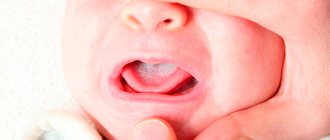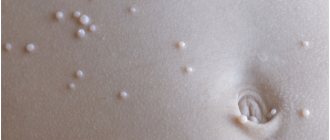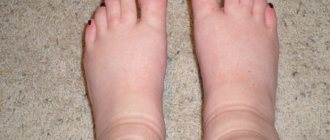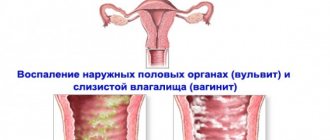From this article you will learn:
- what stomatitis looks like in children: photo in the mouth,
- symptoms and treatment,
- How to quickly cure childhood stomatitis at home.
The article was written by a dentist with more than 19 years of experience.
Stomatitis is a disease in which lesions appear on the oral mucosa, most often in the form of single or multiple erosions or ulcers (aphthae). But in a child, this disease can have other manifestations. For example, against the background of stomatitis of viral origin, you can often see bright red swollen gums, sometimes even covered with a whitish coating. This combination of stomatitis and gingivitis is already called the term “gingivostomatitis”.
There are 3 main types of stomatitis in children:
1) acute herpetic stomatitis, 2) chronic recurrent herpetic stomatitis, 3) chronic aphthous stomatitis.
Depending on the form of stomatitis in children, symptoms and treatment will vary greatly, because Depending on the cause of stomatitis (herpes virus, bacteria, allergies, immune pathology), completely different drugs are prescribed. Therefore, if you decide to treat stomatitis in a child at home, carefully read the symptoms of different forms of stomatitis to choose the right type of treatment.
Forms of stomatitis of moderate severity (especially those not accompanied by severe symptoms of intoxication and dehydration) can be successfully treated independently with means for topical use in the oral cavity. But treatment of severe cases may require not only the intervention of a doctor, but also, as sometimes happens, including systemic drug therapy and even hospitalization.
Herpetic stomatitis in children: symptoms and treatment
Herpetic viral stomatitis in children has 2 forms of the disease. Firstly, there is acute herpetic stomatitis, which develops during primary infection with the herpes virus (i.e. the very first case of the disease). This acute form of stomatitis is typical only for very young children, and most often occurs in a child aged 9 to 28 months.
Herpetic stomatitis in newborns/infants is rare. This is due to the fact that at this age there are still quite a lot of antibodies specific to the herpes virus in the child’s blood, obtained during pregnancy with the mother’s blood. Therefore, it rarely occurs in children under 3 months of age. The second form of the disease is chronic recurrent herpetic stomatitis (i.e. all repeated cases).
a) Acute herpetic stomatitis –
As we said above, the primary case of herpetic stomatitis develops in children most often between the ages of 9 and 28 months. This is due to the fact that at this age the child’s antibodies specific to the herpes virus, received from the mother, gradually disappear. The important point here is that if the primary case of the disease develops against the background of a still sufficiently high level of antibodies to the herpes virus received from the mother, the symptoms of stomatitis will be very weak.
That is why primary herpetic stomatitis in 90% of children proceeds almost unnoticed, and many parents generally mistake such symptoms for symptoms of teething. However, when primary herpetic stomatitis in children develops against the background of an already sufficiently low level of maternal antibodies to the herpes virus in the blood, the disease is acute (with pronounced symptoms of intoxication).
Herpetic stomatitis in children: symptoms; the duration of clinical manifestations is usually 10-14 days. At the beginning, weakness, malaise, headache, and muscle pain appear, which is associated with intoxication of the body. The temperature (depending on the severity of the disease) by the end of the first or second day can range from 37.5 to 41 degrees. Regional lymph nodes (especially submandibular) are enlarged and painful.
Stomatitis in children: photo in the mouth
Please note that when stomatitis forms on a child’s tongue, herpetic rashes/ulcers can be not only on visible surfaces (for example, on the back and tip of the tongue), but also on the sides, as well as on the lower surface of the tongue (Fig. 6) .
Picture in the oral cavity – the oral mucosa becomes bright red and swollen. During the first 1-2 days after the onset of prodromal symptoms (malaise, fever, etc.), rashes of small blisters appear on the mucous membrane of the lips, cheeks, tongue, palatine arches (Fig. 1) - approximately the size of a millet grain. Bubbles are usually located in groups. The blisters are initially filled with transparent contents, but then it becomes cloudy, and after about 2 days the blisters burst with the formation of bright red ulcerations.
The resulting ulcers very quickly become covered with a whitish or yellowish fibrinous coating (Fig. 2-6). In parallel with this, children very often experience total redness of the gums, which resembles the symptoms of acute gingivitis (Fig. 7-9), and this condition is called herpetic gingivostomatitis. In addition, very often herpetic gingivitis is combined with herpetic rashes on the skin around the mouth and the red border of the lips.
Photo of gingivitis accompanying herpetic stomatitis -
Important: In many cases, ulcers can be very painful. The pain intensifies sharply when the surface of the ulcers comes into contact with water or food during eating. This is why many children refuse to drink, which leads to the development of dehydration. Against the background of dehydration, the symptoms of intoxication become even stronger, which may require urgent hospitalization. Therefore, one of the most important aspects of treating stomatitis in children is to prevent the development of dehydration.
b) Chronic herpetic stomatitis –
After a primary herpes infection, the virus remains in the body for life. Herpes viruses persist for life in the nerve ganglia, and when various unfavorable factors influence the body, the virus is activated. Periodic relapses usually occur due to the following reasons:
- hypothermia, ARVI,
- vitamin deficiency, stressful situations, allergies,
- exacerbation of chronic diseases (tonsillitis, sinusitis...),
- taking corticosteroids,
- trauma to the oral mucosa and red border of the lips,
- foci of dental infection (tartar, dental caries, gingivitis),
- mouth breathing (it causes dry lips and oral mucosa, and as a result, the appearance of cracks).
Symptoms, picture in the oral cavity - the chronic recurrent form of herpetic stomatitis in the oral cavity manifests itself in exactly the same way as the acute form (see clinic and photo above).
The difference is that the general condition, as a rule, does not suffer, i.e. symptoms of intoxication are usually minimal or absent. At the same time, regional lymph nodes are usually enlarged and painful on palpation. Later in the article we will tell you in detail how to treat stomatitis in children at home.
Diagnostics
In most cases, the disease is detected during examination of the oral cavity, after interviewing parents. Different forms of the disease have a different clinical picture, according to which the doctor makes a final diagnosis. If it is suspected that stomatitis is not of a domestic nature, diagnostics of the pathogens is required using laboratory tests.
The following diagnostic methods may also be prescribed:
- examination of samples of material taken from the oral mucosa - cytological, virological, bacteriological;
- taking blood for enzyme immunoassay;
- PCR.
Rarely does stomatitis become chronic when therapy no longer brings the expected results. Additional examinations may be carried out to determine the causes.
Herpetic stomatitis in children: treatment
How to treat stomatitis in a child (herpetic origin) will depend on the severity of the clinical manifestations. For a mild form of the disease, topical medications will be sufficient + be sure to avoid dehydration in the child. But in case of severe herpetic stomatitis, the use of tableted antiviral drugs (such as Acyclovir) + again control of dehydration will be indicated first of all.
It is very important that parents do not treat their child with antiviral drugs in absolutely every case of herpetic stomatitis, because there is a direct relationship: the more frequent and longer the courses of antiviral therapy with Acyclovir, the faster the herpes virus will develop resistance to the drug and it will cease to be effective. Typically, resistance develops after 4-5 courses of antiviral therapy with acyclovir, primarily in children with weakened immune systems.
Treatment of mild/moderate stomatitis –
Removal of symptoms of intoxication - in the prodromal period of the disease, i.e. even before the formation of herpetic blisters on the oral mucosa, there is usually an increase in temperature, lack of appetite, malaise, and possible muscle pain and headache. Parents often mistake this for symptoms of teething. For such symptoms, the child can be given a drug with ibuprofen (for example, children's Nurofen).
But keep in mind that taking antipyretic drugs is not advisable at low temperatures, because this reduces the body’s production of its own interferons and prevents the formation of full immunity to viruses and bacteria. Typically, antipyretics are prescribed to children if their body temperature is not less than 37.8–38.0 degrees (24stoma.ru).
Local treatment of herpetic rashes - after opening the herpetic vesicles, painful ulcers form in their place, and therefore, due to pain, the child may refuse to drink and eat. If this is observed, then it will be very important to avoid the development of dehydration in the child, because it will contribute to a sharp deterioration in the general condition (even with a fairly insignificant severity of damage to the mucous membrane by herpetic eruptions). This can be dealt with by applying either an anesthetic anti-inflammatory gel or special film-forming protective agents to the surface of the ulcers.
Below you will find a comprehensive list of effective medications used for local treatment of herpetic stomatitis. For moderate severity of the disease, such treatment will be sufficient without resorting to systemic tablet antiviral therapy.
1) Antiseptic rinses –
To combat the virus directly, the drug Miramistin, which has activity against the herpes virus, can be used.
For older children who can already rinse their mouths on their own, it is used in the form of mouth rinses 3 times a day for 30 seconds. In young children, this drug is used in the form of a spray, or herpetic lesions can be treated with a gauze swab dipped in a solution of miramistin. → Features of using Miramistin
2) Pain-relieving anti-inflammatory gel –
If the surface of the ulcers is very painful and the child refuses to eat, drink, or brush his teeth, it is necessary to use a remedy to anesthetize the ulcers. The optimal choice is Cholisal topical gel, which can be used from 0 years (there are no age restrictions). This gel has not only an analgesic, but also a pronounced anti-inflammatory effect.
But sprays and gels based on lidocaine (for example, Kamistad) will not be a good choice in this case, because lidocaine will mix with saliva, gradually leading to numbness of the entire mouth. In a young child, this can cause numbness of the tongue, and as a result, difficulty swallowing and choking on saliva.
→ Scheme and features of using Cholisal-gel
3) Protective film-forming agents –
For a long time, you can protect the surface of ulcerations from the action of irritants not only with the help of an anesthetic gel, but also with special products that, when applied, form a thin protective film on the surface of the ulcer. Such a film will not only reduce pain and inflammation, but also accelerate the subsequent epithelization of ulcers. These drugs include preparations based on bismuth subsalicylate.
Typically, drugs with this component are used in the treatment of gastric and duodenal ulcers. Drugs of this series for herpetic stomatitis can be used in the form of a suspension for application to the surface of oral ulcers, or in the form of chewable tablets. As a result of application, an insoluble protective film is formed on the surface of the ulcers, which will reduce pain and inflammation.
Protective gel Gerpenox (from the manufacturer Rox) can also be classified as film-forming agents. This medication contains hydroxyethylcellulose as well as Chelate Organic Germanium Guanine Complex. These components also create a protective film on the surface of the ulcers, which protects the ulcers from exposure to irritants and thereby reduces pain, and secondly, it will speed up the healing of the damaged mucous membrane by about 1 day.
4) Drugs from the Viferon line –
In Russia, treatment of herpetic stomatitis in children is often carried out: in young children with Viferon suppositories (with dosages of interferon 150,000, 500,000 or 1,000,000 IU), in older children and adults - with Viferon in gel form. This treatment method involves so-called interferon alpha-2b replacement therapy, which according to the manufacturer has antiviral and immunomodulatory effects.
We note that in countries with the highest level of medical care (Europe and the USA), therapy with externally administered interferons is considered not very effective, and research in this direction was curtailed after 1990-2000. However, for the sake of completeness, we provide below a link with Viferon treatment regimens recommended by the manufacturer. We can say only one thing for sure: it is definitely harmless + such drugs can still have some small positive effect. However, in our opinion, it is definitely not worth counting on such therapy for severe cases of the disease.
→ Treatment regimens with Viferon
5) Oral hygiene for stomatitis –
Because Ulcerations can be very painful—brushing your teeth can be painful, but that doesn’t mean you have to give up your hygiene. The accumulation of large amounts of bacterial plaque on the teeth and tongue can lead to the development of bacterial complications, for example, necrotizing ulcerative gingivostomatitis. To reduce pain when brushing your teeth, use a toothbrush with soft bristles.
If the child does not yet have teeth, treatment is carried out using a gauze swab soaked in an antiseptic solution. At the end of the article you will also find information on children's toothpastes that are best used to prevent the occurrence of new cases of stomatitis.
Treatment of SEVERE stomatitis –
Next, we will tell you how to treat oral stomatitis in children (caused by the herpes virus) if the child develops severe clinical manifestations.
It remains extremely important to prevent the development of dehydration, which can develop due to the child's refusal to drink water, and it is also necessary to monitor elevated temperature and other symptoms of intoxication. In parallel, local drugs are used (Miramistin, as well as Cholisal - for pain relief of ulcers). 1) Systemic antiviral therapy –
However, if severe herpetic stomatitis occurs, the main treatment in children should be with already tableted antiviral drugs (such as Acyclovir, Valacyclovir, Famciclovir). The peculiarity of their use is that they will be effective only if taken in the first 72 hours of the disease. Moreover, the later you start taking it, the less the effect will be. Therefore, the best results of therapy are achieved when starting treatment in the first 12 hours from the moment the herpetic rash appears.
- The drug "Acyclovir" (instructions for the drug) is the main antiviral drug for children, which is quite well tolerated and has few side effects.
For children over 2 years of age and adults, the effective dosage will be the same - 400 mg 5 times a day (5 days in total). Often in the instructions you can find information that the basic dosage is 200 mg, and not 400 mg 5 times a day. This dosage is not effective, and here's why... Randomized clinical trials (source) showed that oral acyclovir (200 mg 5 times a day, for 5 days) had virtually no effect on either the duration of pain or healing time herpetic ulcers. Moreover, it was the dosage of 400 mg according to the above scheme that led to a more rapid reduction in pain and healing of ulcers. As for children under 2 years old, at this age the dosage is simply reduced by exactly 2 times.
Important: the use of acyclovir may not be effective in children with weakened immune systems, because in this case, the herpes virus may develop resistance to acyclovir. Therefore, in children with weakened immune systems, many experts recommend using antiviral drugs only in extreme cases, and focusing on local therapy + immunostimulating drugs that will stimulate the body’s production of its own interferons.
Remember that the herpes virus quickly develops resistance to acyclovir, and it affects not only the state of the immune system, but also the frequency/duration of courses of antiviral therapy. Those. The more often you take acyclovir, the faster it will lose its effectiveness. However, if acute primary (with severe symptoms of intoxication) stomatitis occurs in an infant, treatment should begin with the immediate use of antiviral drugs, such as Acyclovir.
2) Immunostimulating agents –
As we said above, drugs in this group can be considered as an alternative to antiviral drugs if the herpes virus develops resistance to them, or if the child has a weakened immune system. Such drugs cannot be prescribed to your children on your own, because introduction into the immune system by a non-specialist can only do harm and in the future only worsen the situation. Therefore, drugs of this series should be prescribed only by a doctor.
How to treat stomatitis in children with a weakened immune system - the drug Cycloferon, which is an inducer of the body’s own interferon, can help you with this. This drug can be prescribed to children from 4 years of age. The drug is taken once a day (half an hour before meals, washed down with plenty of water). A single dosage for children 4-6 years old is 150 mg, for children 7-11 years old - 300-450 mg, for adults and children over 12 years old - 450-600 mg.
Although this medicine is over-the-counter, before taking it it is advisable to consult with an immunologist and pediatrician about the treatment strategy for herpetic stomatitis in your child and choose the best option. Remember that when we artificially force the body to produce an increased amount of interferons, it gradually stops doing this altogether without additional artificial stimulation. Therefore, everywhere you need to maintain a balance and consult with specialists.
Important: herpes on the red border of the lips or herpetic stomatitis - in children is often complicated by herpetic lesions of the eyes and skin around them. This is due to the fact that the child first licks his fingers and then touches his eyes with infected hands. What to do about it - read the link above.
Additional measures
In infancy, any disease develops much more rapidly due to the insufficient development of the immune system to repel attacks of the body by pathogens. Do not underestimate the danger of the disease - at the first signs of stomatitis in a child, you should urgently visit a doctor. He will evaluate the form, determine how best to treat, whether traditional medicine methods and homeopathy are allowed.
Rinsing
This is an effective way to help. It involves a local effect on pathogenic microorganisms. The procedure can be carried out using a chamomile solution. When the baby does not yet know how to rinse his mouth, the mother wipes the oral mucosa with a swab dipped in a medicinal solution. Miramistin works well, but in its absence it is enough to prepare a solution of soda, salt and water yourself.
Mouth treatment
To treat the mouth, ointments or gels are prescribed - Actovegin, Solcoseryl. There are other effective remedies that perfectly resist inflammation and have an antibacterial effect. For example, Chlorophyllipt. It is prescribed by many pediatricians.
Also safe for babies:
- Kalgel;
- Baby Dent;
- Furacilin;
- Holisal.
Folk remedies
For the treatment of stomatitis in children, calendula is considered the most popular folk remedy. It does not provoke allergies and is non-toxic.
When breastfeeding, you need to treat the nipples with infusions of herbs - marigold, chamomile. It takes at least 1 hour to insist.
A good remedy is aloe leaf juice; it helps heal pustules much faster. The leaves are pushed apart, rolled through a meat grinder, and a piece of gauze is soaked in the juice to lubricate the affected areas.
Onion peel is characterized by its antiseptic effect. You can also make a decoction from it. First, wash the husks thoroughly, add cold water, cook until boiling and let stand. It is better to do this at night so that the product is ready by morning.
Effective methods include:
- Carrot juice. This method is suitable for children who have already been introduced to vegetable complementary foods. Grate the carrots on a fine grater, squeeze out the juice, and coat the mucous membrane. The juice must be diluted with boiled water in half.
- Yarrow decoction. Brew the medicinal plant in the usual way - 2 large spoons per cup of boiling water. After 20 minutes, the infusion can be used, rinsed with mouth or lubricated with gauze.
- Oak bark decoction. This is an effective method against fungal infections and pathogenic microbes. The bark is first cooked in a water bath - a small spoon per quarter cup of boiling water. Herbs and roots should not touch metal, so they should be cooked in enamel, ceramic dishes.
It is not recommended to use infusions without the approval of your pediatrician.
Vitamins
When a child gets stomatitis, there is most likely a deficiency of microelements in the body. Usually, along with the main treatment, the doctor prescribes a complex of vitamins, which necessarily contains A, PP, C, and potassium. They help speed up recovery.
Vitamin A can be used to treat affected areas. If you refuse vitamins, there is a high probability of frequent infection with stomatitis.
Chronic aphthous stomatitis in children –
The aphthous form of stomatitis is manifested by the formation of one or more single ulcers on the oral mucosa. Typical localization of ulcers is the mucous membrane of the cheeks and the inside of the lips, the soft palate, the surface of the tonsils and palatine arches, as well as the lower and lateral surfaces of the tongue. Less commonly, ulcers can occur on the back of the tongue, the red border of the lips, or the mucous membrane of the gums.
Unlike herpetic stomatitis, with aphthous stomatitis the general condition practically does not suffer, but a slight temperature and enlargement of the submandibular lymph nodes may still be present. In addition, with aphthous stomatitis, most often only 1 ulcer (or no more than 2-3) is formed - usually ranging in size from 0.5 to 1.0 cm in diameter. In rare cases, ulcers can reach 2-3 cm in diameter.
Aphthous stomatitis in a child: photo
If you look closely at the photo above, you will notice that the surface of the ulcers is always covered with a gray or yellowish necrotic coating. In addition, the perimeter of the ulcer is always surrounded by a bright red rim of inflamed mucous membrane. Ulcers up to 0.5 cm in diameter usually heal in 6-8 days, about 1 cm in diameter - in about 10-14 days without scarring.
But larger ulcers with a diameter of 2-3 cm will take much longer to heal - up to 6 weeks, and healing most often occurs with the formation of a scar on the mucous membrane. It should also be noted that almost always ulcers are sharply painful when touched, and therefore children may refuse to drink, eat, or brush their teeth with a toothbrush.
Causes of aphthous stomatitis –
The causes of this form of stomatitis have not been fully studied, but it has been established that the following factors can trigger the development of aphthous stomatitis:
- allergy to components of oral hygiene products (especially often to sodium lauryl sulfate),
- food allergens,
- some pathogenic bacteria
- biting the mucous membrane of the cheeks and lips,
- trauma to the mucous membrane from the sharp edge of a filling or during an anesthetic injection,
- large amounts of nitrates in drinking water and foods.
In addition, there is a large list of chronic diseases and conditions of the body that can also cause aphthous stomatitis or increase the risk of its development. This especially often occurs against the background of pathologies of the gastrointestinal tract, immune system, blood diseases, etc.
How to distinguish herpetic and aphthous stomatitis -
- Herpetic stomatitis in a child is manifested by the formation of many small blisters, which then burst with the formation of numerous small aphthae (although they can then merge to form one extensive ulceration). With aphthous stomatitis, the aphthae are single in nature, and usually they are much larger in size - most often from 5 to 10 mm.
- With herpetic stomatitis, as a rule, there is redness and swelling of the marginal gums around all teeth, which looks like acute gingivitis (Fig. 7-9). With aphthous stomatitis, symptoms of acute gingivitis are never observed.
With herpetic stomatitis, as a rule, rashes of blisters also appear on the red border of the lips and the skin around the mouth (Fig. 16). With aphthous stomatitis, no rashes can form on the skin around the mouth; the maximum that is possible is single aphthae may be present on the red border of the lips.
Possible complications
The mucous surface in the mouth can quickly recover, so the disease recedes after a short period of time, the ulcers heal in about 3-5 days. To prevent re-infection, it is imperative to replace your toothbrush.
With stomatitis, the immune system is overloaded. The child is susceptible to infections: pharyngitis, tonsillitis, acute respiratory infections, acute respiratory viral infections. A common sign of pathology is nasal congestion, which promotes breathing through the mouth and drying out of the mucous membrane. Cold air with pathogens penetrates the larynx, provoking inflammatory processes. If a baby is often affected by stomatitis, then the tooth enamel suffers, which is why temporary teeth can last much less than the time allotted to them.
Aphthous stomatitis in children: how to treat
If a child has developed aphthous stomatitis, treatment should be aimed at eliminating pain and speedy healing of ulcers, but it is very important to try to determine the possible cause of the disease in order to prevent the development of new outbreaks. Therefore, immediately after you discover aphthae in a child, you must immediately exclude allergenic foods from the diet (honey, strawberries, chocolate, nuts, citrus fruits). The same applies to hot, spicy, rough foods, highly salty and sour foods (tomatoes, pineapple, fruit juices are not allowed), as well as carbonated drinks.
Check to see if your child's toothpaste contains sodium lauryl sulfate. If there is, it is urgently necessary to replace it with a paste without this component. Elimination of other local causative factors will require a visit to the dentist. Because an allergic reaction is one of the most common causes of the development of this form of stomatitis - it makes sense to immediately start taking antihistamines (anti-allergy) drugs for a course of 10 days.
Local treatment in the oral cavity –
Treatment of aphthous stomatitis with mild to moderate symptoms is usually sufficient with drugs for topical use in the oral cavity, + sometimes physiotherapeutic procedures and laser are used.
- Antiseptic rinses - they are necessary because... Pathogenic bacteria of the oral cavity are often involved in the development of aphthous stomatitis. For very young children, it is optimal to use Miramistin spray for this, and for older children (who are already able to rinse their mouths themselves) - 0.05% chlorhexidine solution. The spray can be used either to irrigate oral ulcers, or to moisten a gauze pad with it to treat the mucous membrane. Scheme: 3 times a day, for 10 days.
- Treatment of ulcers with anesthetic gel -
To anesthetize ulcerations and reduce inflammation in the tissues around them in children, it is optimal to use an anti-inflammatory drug in the form of an oral gel - called Cholisal. The drug has no age restrictions. You can treat ulcers 2-3 times a day, usually 7-8 days are enough - after which it is advisable to switch to agents that accelerate epithelization.
- Laser treatment - the use of a special medical diode laser with a wavelength of 940 nm, or an Nd: YAG laser - almost instantly after a single procedure reduces pain and also provides significantly faster healing.
For example, laser-treated ulcers measuring 0.5 cm in diameter are completely epithelized in just 3-4 days (instead of 7-10 days). This treatment is usually carried out in private medical centers. A weaker alternative to laser is UVR (ultraviolet irradiation of the oral cavity). This method of physiotherapy also helps to accelerate the healing of ulcers with aphthous stomatitis, and the device is available in any physiotherapy room at a children's dental clinic. You can get a referral to a physical therapy room from your dentist or pediatrician.
- Epithelizing agents - after pain and inflammation have subsided, it is necessary to focus on the rapid epithelization of ulcers. This can be done with the help of special means that accelerate the epithelization of damage to the oral mucosa, for example, the drug Solcoseryl in the form of a gel. It should be noted that this gel also has a moderate analgesic effect.
Treatment of severe aphthous stomatitis -
With severe symptoms, long-term non-healing ulcers, as well as in the case of regular occurrence of this form of stomatitis, home treatment with topical preparations is no longer enough. It is very important to examine the child under these conditions. Depending on your symptoms, you may need to perform a complete blood count to rule out hematologic diseases, tests for plasma immunoglobulins and lymphocytes, and different types of plasma antibodies to rule out autoimmune diseases.
Typically, for severe aphthous stomatitis, the following types of drug therapy are used:
- a single injection of glucocorticoids into the base of each ulcer,
- systemic therapy with glucocorticoids,
- taking immunomodulators.
Important: detailed local treatment regimens, as well as which systemic pharmacological drugs can be used in severe cases of aphthous stomatitis - read the article: → Treatment regimens for aphthous stomatitis
After stopping - destroy
The main treatment of aphthous stomatitis in children is aimed at destroying its causative agent.
Antibacterial agents will get rid of pathogens: Grammidin, Hexoral, Lizobakt, Strepsils, Lugol, Tantum Verde, Faringosept.
We have indicated above how to cure aphthous stomatitis of viral origin.
If the disease occurs against the background of an allergic reaction, you will need antihistamines: Suprastin, Tavegil, Rivtagil, Diprazin, Supramin.
During the entire treatment, the child must eat according to certain rules, which we wrote about in the article “What can you eat with stomatitis.”
Prevention
The main method of preventing stomatitis is the rules of hygiene. It is necessary to constantly ensure that children do not lick dirty objects or hands.
Breastfed babies are less likely to be affected by the disease, regardless of its form. Elders need to be explained the importance of washing hands and brushing teeth.
Proper nutrition with a moderate amount of sugars, reasonable exercise, and frequent walks help strengthen the immune system. This way, the baby will not get sick even if an infection occurs.











